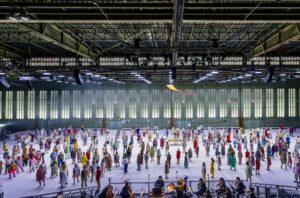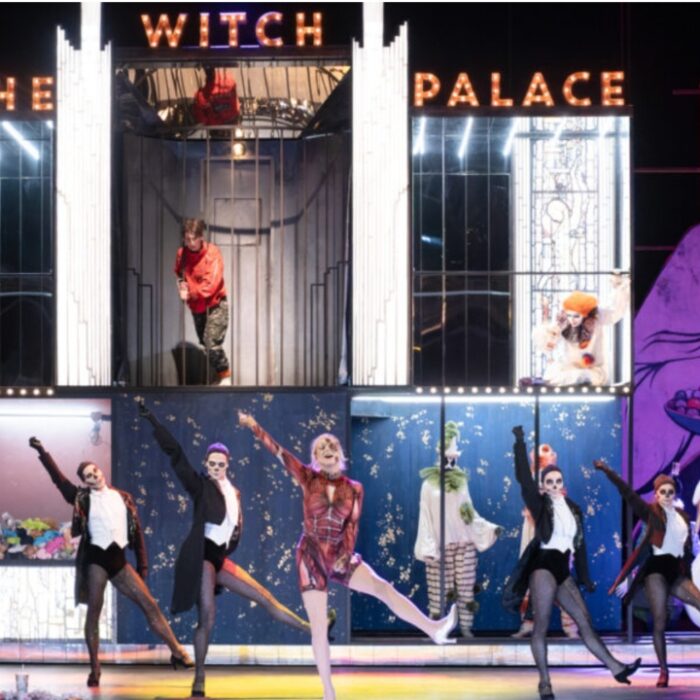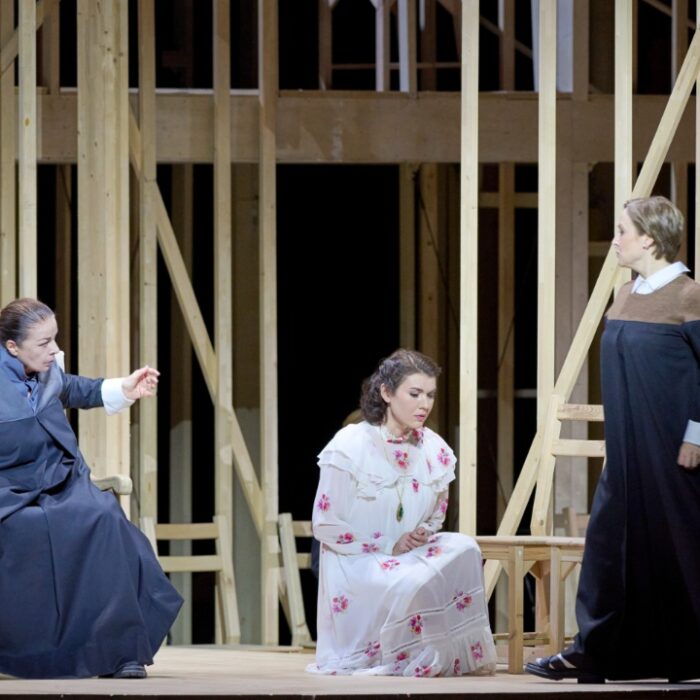
Komische Oper Berlin 2024-25 Review: Messiah
By Zenaida des Aubris(Photo: Jan Windszus Photography)
Ever since its premiere in 1742, George Frederic Handel’s “Messiah” has been considered a work of vocal and intellectual power. All the more so when it is performed in an airport hangar, with over 350 choir members, dramatically staged, on a stage over 180 feet wide. The Komische Oper Berlin hashtags #everything extraordinary – in large illuminated letters on the airport‘s runway – to stay relevant.
“Messiah” of Interesting Concepts
Opera director Damiano Michieletto juxtaposes the three parts of the oratorio in an unusual way. Conventionally, the first part is the prophecy and birth of Christ from the Old Testament; the second part is the suffering, death and resurrection of Jesus; and the third part is about resurrection and eternal life. Michieletto inserts a dramatic plot that tells the true story of a young woman who receives a diagnosis of an incurable brain tumor and is given a prognosis of only a few months to live. She decides to avoid an expectedly painful death and to choose when to leave this life with a physician-assisted suicide. Although her family respects her decision, she faces hostility from society. The woman – she is never referred by her name – stands by her decision and, supported by her family, finds comfort in the sight of a green laurel tree, which gives her hope that life continues even though she dies. Thus Handel’s four soloists become the woman’s husband, her parents and the doctor.
Whether this interpretation does justice to the text is a matter of interpretation. It is certainly a very pon point topic – see the constantly evolving laws worldwide in the field of medically assisted suicide, which allow for taking personal responsibility of one’s own life and death. The winner of the Golden Lion at this year’s Venice Film Biennale, “The Room Next Door” by Pedro Almodóvar with Tilda Swinton and Julianne Moore, deals with this very topic.
Michelietto does not make it easy for the audience to abstract the leap from the Old Testament texts into the 21st century. The staging is always visually stunning: set designer Paolo Fantin uses a single white surface on which only minimal props are used – a laurel tree, a table with 4 chairs, a tomography device and a photocopier. The paradisiacal garden at the end of the third part is carried in by the chorus singers in pieces. In addition, the colorful and pastel-colored everyday clothing chosen by the costume designer Klaus Bruns for the chorus and supernumeraries signalizes that this story could take place anytime, anywhere.
As difficult as it is to decipher and categorize the direction and concept, it is very easy to understand it on the musical side. In a word – magnificent – the performances of the soloists, the choir, the orchestra. Of course, all the sound bodies in the hangar are amplified, but this amplification is so successful and balanced that you don’t notice it – bravo to the sound designer Holger Schwark.
Illuminating Performances
Soprano Julia Grüter is the doctor who, with a warm, crystal-clear timbre, is the harbinger of bad news but also the bringer of comfort, which is particularly evident in her aria in the third part, “I know that my Redeemer liveth.” This is one of the most emotional and heartfelt arias in the entire work, where she sings of the resurrection of Christ and the hope for eternal life. As the mother, Rachael Wilson’s mezzo is poignant and plaintive, highlighting the emotional depth of her words. Julien Behr masters the virtuoso coloratura of the tenor role with bravura as the woman’s husband. Tijl Faveyts, as the father, makes sovereign use of his colorfully nuanced bass, especially in the third part of “The Trumpet Shall Sound,” accompanied by a festive trumpet that gives the aria an uplifting moment.
“Messiah” is a choral work par excellence and in this production there are ten different choirs working with the choirmaster David Cavelius, giving the famous “Hallelujah Chorus” in the second part particular brilliance. But not only there – Handel’s skillful contrapuntal structure gives the text an additional dimension, with the musical lines reflecting a healing and redemptive effect. The choir creates an unforgettable atmosphere, especially in the dense, silent harmonies.
The orchestra and conductor George Petrou are placed in the center of the grandstand. Many strategically placed monitors provide visual communication between the soloists and the choir, which is spread across the wide stage. “Messiah” has relatively modest instrumentation – strings, oboes, bassoon, trumpets and timpani, accompanied by harpsichord and continuo – but each instrumental group has a clear function. The strings often dominate, creating a warm, resonant blanket of sound, while the woodwinds are used selectively to add refinement. This simplicity of orchestration gives the work a lightness that highlights the beauty and clarity of the vocal lines. In the large choral numbers, Petrou unleashes the full power of the orchestra. He makes particularly impressive use of the trumpets and timpani, which enhance the festive, triumphant atmosphere.
This “Messiah” clearly plays on two levels. Both are valid: musically, the ensemble with the soloists, choirs and orchestra shines; dramaturgically, Damiano Michieletto shows us, as he says, “it is not about evoking fear or unease, but about introducing the audience to death with a different awareness.” Whether he succeeds in this is, of course, a very individual experience. But it is courageous to address the topic of physician-assisted suicide and express it artistically, since it also makes a large part of the audience – the majority over 50 years old – think about their own mortality and how they want to and can shape it.
More Highlights
Once again, the Komische Oper Berlin, which incidentally has just been named Best Opera House of the year by the International Opera Awards, gives us not only an entertaining but insightful and thoughtful production in the spectacular setting of Hangar 4 at Tempelhof Airport. Built between 1936 and 1941, Tempelhof Airport was the largest building in the world at the time, with 307,000 square meters of floor space and a roof designed as a grandstand to hold up to 80,000 spectators for air shows. While the airport was used for monumental self-staging during the Nazi era, it became a symbol of freedom in the post-war period with the airlift 1948-49, when Berlin was cut-off by the Soviet regime of the time, from receiving any goods – from food to heating to other necessary resources from June 1948 to May 1949. During this time, US and UK airforces delivered 2.3 million tons of food, fuel and supplies to West Berlin in more than 278.000 airdrops. Since its closure in 2008, the seven hangars have been home to refugees, social projects, cultural and sporting events, among other things. A most fitting place for a “Messiah” and its message of eternal life!



